Owls have long captivated our imaginations with their mysterious and stealthy nocturnal ways. One of the most intriguing aspects of these enigmatic birds is their almost supernatural ability to fly in near silence.
Unlike many other birds, whose wing flaps and calls can be heard from a distance, owls seem to glide through the night with a hushed elegance that leaves us in awe. But why are owls quiet when flying?
In this article, we will delve into the remarkable adaptations and evolutionary advantages that make owls the silent hunters of the avian world.
From specialized feathers to unique wing morphology, owls have evolved an array of silent flight mechanisms that enable them to stalk their prey with astonishing stealth.
Join us on a journey into the world of owls, as we uncover the fascinating science behind their silent flight and gain a deeper understanding of these remarkable creatures.
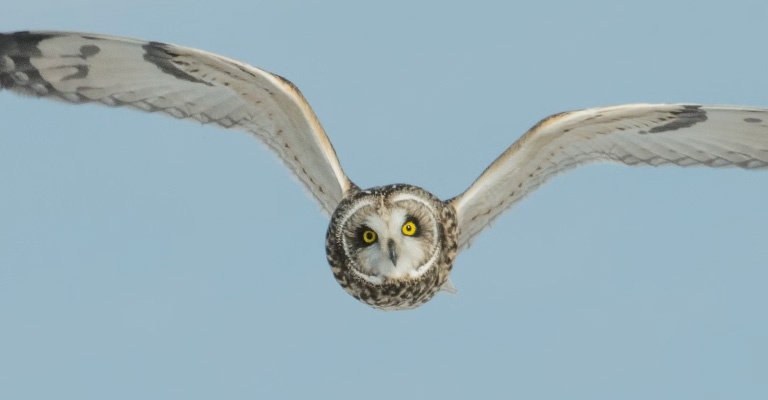
Why Are Owls Quiet When Flying?
To understand why owls have evolved silent flight, we must first consider their ecological niche and hunting strategies. Owls are primarily nocturnal hunters, which means they rely on the cover of darkness to stalk and capture their prey.
In the dead of night, many potential targets have heightened senses of hearing, making them acutely aware of any approaching danger. This is where silent flight becomes a crucial adaptation for owls.
Imagine the contrast between a typical bird’s flight and that of an owl. Most birds produce noticeable flapping sounds as they fly. These sounds are generated by the motion of their wings, primarily due to the turbulent airflow over their feathers.
For a diurnal predator, this may not be a significant issue, as their prey is less sensitive to auditory cues during the day. However, for owls, the element of surprise is their greatest advantage.
They need to get as close as possible to their prey without alerting them. This is where their silent flight comes into play, allowing them to approach unsuspecting rodents, birds, and other small animals without giving away their presence.
Feathered Innovations: Silent Flight Mechanisms
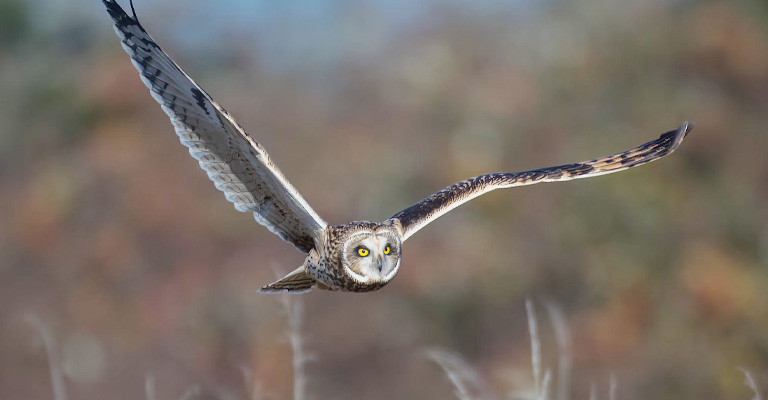
Owls possess a range of specialized adaptations that contribute to their silent flight. These adaptations center on their feathers and wing morphology.
Fringed Feathers
The leading edge of an owl’s wing is equipped with fringed feathers. These fringes break up the turbulent airflow that typically causes noise during flight.
The fringes are composed of soft, velvety barbs and barbules, which muffle the sound of air rushing over the wing’s surface. This design effectively reduces the noise produced during flight.
Serrated Edges
Unlike the smooth and flat feathers of most birds, owl feathers have serrated edges. These serrations act like a comb, further breaking up the airflow over the wing’s surface and minimizing turbulence.
This results in a quieter flight by reducing the sound generated during wing flaps.
Velvet-like Texture
Owl feathers are exceptionally soft and velvety in texture, which reduces the sound of feathers rubbing against each other. This velvet-like texture also absorbs sound, adding to the overall silence of an owl’s flight.
Silent Plummage
In addition to their wing feathers, owls have downy feathers on the rest of their body. These feathers help dampen any residual sound created by body movement and further contribute to their stealthy flight.
Wing Morphology and Flight Efficiency
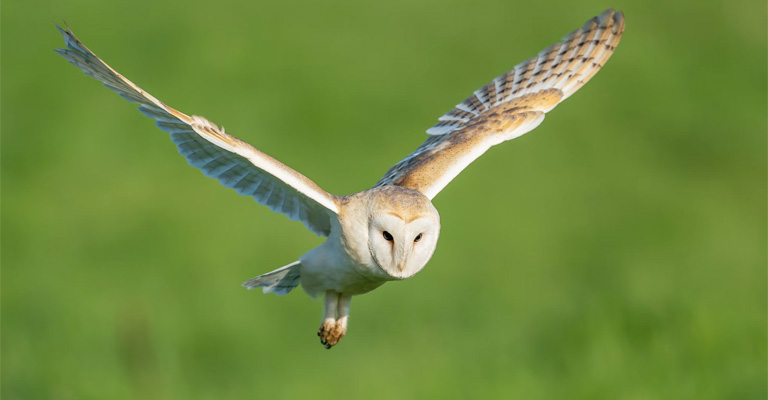
Apart from their feather adaptations, owls have evolved specific wing morphology that enhances their flight efficiency and noise reduction.
Large Wings
Owls have large wings relative to their body size, allowing them to glide gracefully through the air with minimal effort. This feature reduces the need for rapid, noisy wing flapping that is characteristic of many other birds.
Long Primary Feathers
The primary feathers at the tips of an owl’s wings are especially long, enabling the bird to generate more lift while gliding silently. This reduces the need for excessive flapping, which would create noise.
Flexible Wing Shape
Owls can alter the shape of their wings to control their flight silently. This adaptability allows them to navigate through a variety of conditions, from dense forests to open fields, without compromising their stealth.
Hunting Strategy and Hearing Abilities
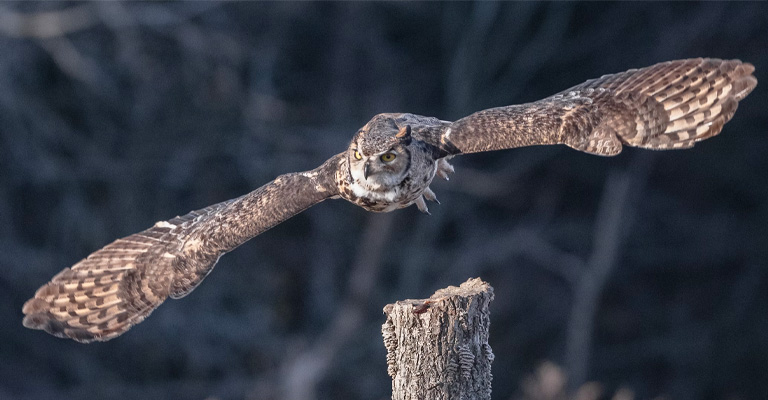
The evolution of silent flight in owls is intrinsically linked to their hunting strategy and extraordinary hearing abilities. Owls are expert listeners, relying on their acute sense of hearing to locate prey in the dark.
Their facial discs, which collect and direct sound waves towards their ears, are crucial for this purpose.
The combination of silent flight and exceptional hearing allows owls to approach their prey without being detected. As they glide towards their target, they can pinpoint the exact location of their prey with remarkable precision.
The element of surprise becomes their greatest asset, as they can strike swiftly and accurately.
The Ongoing Mystery
Despite our growing understanding of the science behind owls’ silent flight, there is still much to discover about the intricacies of this remarkable adaptation.
Researchers continue to investigate the exact mechanisms at play and how they vary among different owl species.
The study of owls’ silent flight not only deepens our appreciation for the wonders of the natural world but also inspires innovation in fields such as aeronautics and noise reduction technology.
What Do Owls Do When They Are Scared?
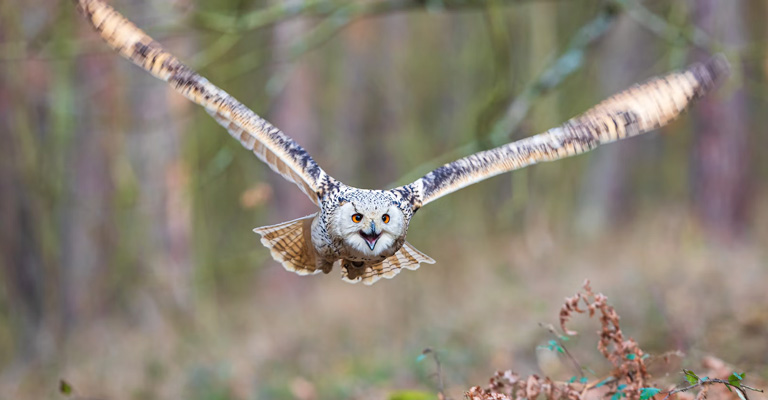
Owls, with their enigmatic and often solitary lifestyles, are remarkable birds that have a unique set of behaviors when they find themselves in potentially scary or threatening situations.
While owls are known for their stoic and composed demeanor, they do exhibit certain responses when they feel scared. In this article, we’ll explore what owls do when they are frightened or perceive a threat.
Hiding and Camouflaging
One of the primary defense mechanisms owls employ when they sense danger is to hide or use their exceptional camouflage.
Owls have evolved a cryptic and often strikingly effective form of camouflage, which allows them to blend seamlessly into their natural surroundings.
When threatened, they may choose to stay perfectly still, relying on their cryptic plumage to make them virtually invisible to predators. Their ability to sit silently in the foliage or on a tree branch, appearing like a part of the environment, helps them evade potential threats.
Alertness and Vigilance
While owls may appear calm, they are incredibly vigilant birds. When they sense danger, they become intensely alert and maintain a keen watch on the source of the perceived threat.
Their large, forward-facing eyes provide excellent binocular vision, allowing them to focus on a specific target. In response to a potential threat, an owl will often turn its head to maintain a direct line of sight to the danger.
Their ability to rotate their heads up to 270 degrees ensures they can keep a close eye on any potential predator.
Defensive Postures
When owls feel threatened, they may adopt specific defensive postures. One common defensive posture involves raising their ear tufts (feathers that resemble horns) and fluffing up their plumage to appear larger and more menacing.
They may also puff up their feathers to create the illusion of a larger body, making themselves seem more formidable to a potential attacker.
Vocalization
Owls are known for their vocalizations, which they use for various purposes, including communication and territory defense. When they feel threatened, some owl species may resort to vocalizing to deter or warn potential threats.
The hooting, screeching, or hissing sounds emitted by owls can serve as a way to intimidate or deter other animals from approaching them.
These vocalizations are not only a means of self-defense but also a way to communicate with other owls and maintain territory boundaries.
Bill Clacking
Bill clacking is a behavior observed in some owl species when they feel threatened or agitated. It involves the owl rapidly opening and closing its bill, creating a distinctive clacking sound.
This behavior is often seen in response to a perceived threat and may serve as a warning to potential aggressors.
FAQs
Why do owls have such large eyes?
Owls have large eyes as an adaptation to their nocturnal lifestyle. These big eyes allow them to gather more light, enhancing their night vision. Owls can see in low light conditions and even in complete darkness, giving them an advantage as nocturnal hunters.
How do owls turn their heads so far around without breaking their necks?
Owls can turn their heads up to 270 degrees, thanks to their specialized anatomy. Unlike humans and many other animals, owls have extra neck vertebrae and a flexible neck structure that allows them to rotate their heads without injuring themselves.
What do owls eat, and how do they hunt?
Owls are carnivorous birds that primarily feed on small mammals, birds, and occasionally insects or fish, depending on their species and habitat. They are skilled hunters and use their exceptional night vision and acute hearing to locate prey.
Can owls see in complete darkness?
Owls cannot see in absolute darkness, but their night vision is highly adapted to low-light conditions. They can see in moonlight or starlight, which gives them an advantage in hunting during the night.
Do all owls hoot, and are hoots used for communication?
Not all owls hoot, and the sounds they make vary among species. Hooting is more common in some owl species, and it is often associated with territory defense and courtship.
Conclusion
The silence of owls in flight is a remarkable feat of evolution, shaped by millions of years of adaptation to their nocturnal lifestyle and hunting strategies.
Owls have developed an arsenal of unique features, from specialized feathers with serrated edges to a wing design that minimizes noise production, allowing them to move through the night undetected.
This silent flight not only helps them hunt effectively but also showcases the incredible diversity and ingenuity of the natural world.
Understanding the science behind owls’ silent flight is not only a testament to the marvels of nature but also a source of inspiration for technological advancements.
Scientists and engineers have drawn insights from owl adaptations to develop quieter aircraft, with potential applications in fields ranging from aeronautics to renewable energy.
The silent flight of owls continues to captivate our imagination and remind us of the countless mysteries waiting to be unraveled in the natural world.
As we appreciate the elegance and efficiency of these nocturnal hunters, we gain a deeper appreciation for the complexity and beauty of the animal kingdom.